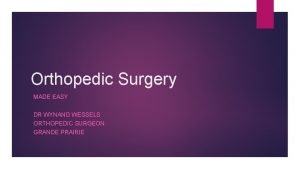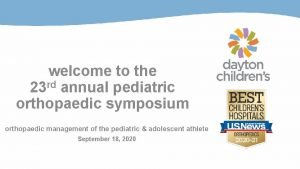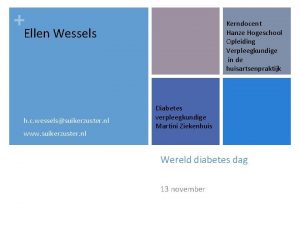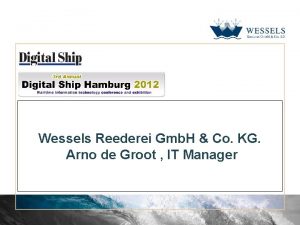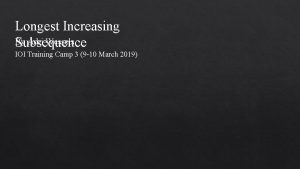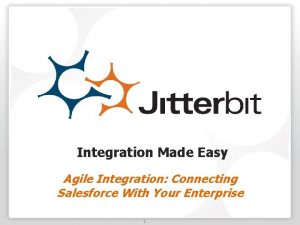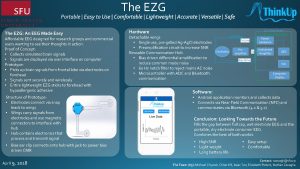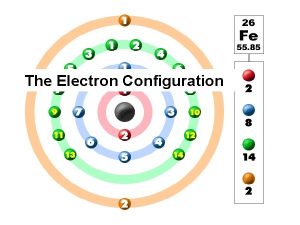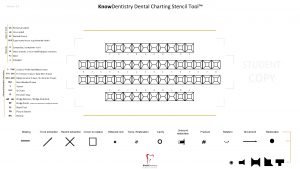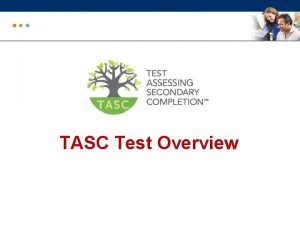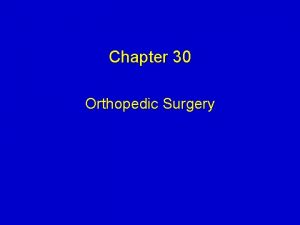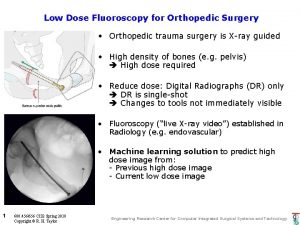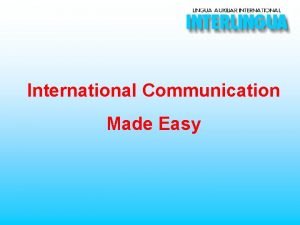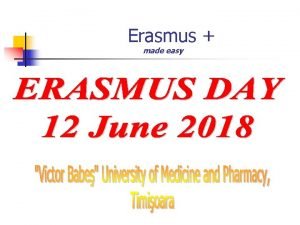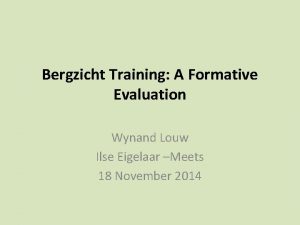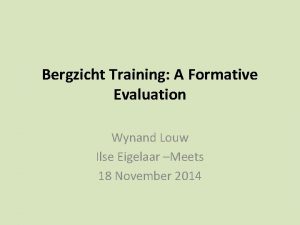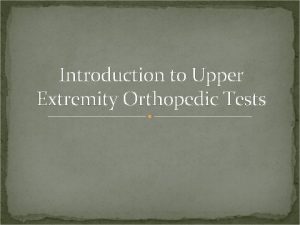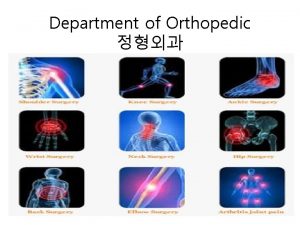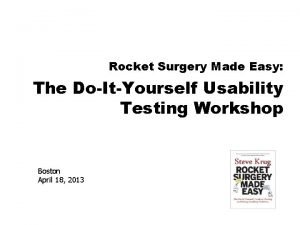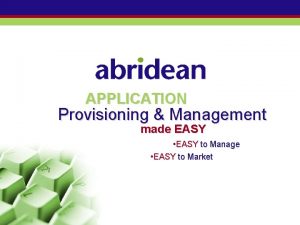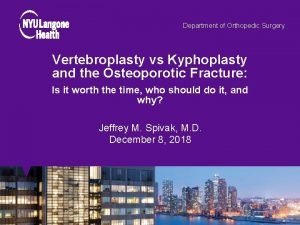Orthopedic Surgery MADE EASY DR WYNAND WESSELS ORTHOPEDIC
























- Slides: 24

Orthopedic Surgery MADE EASY DR WYNAND WESSELS ORTHOPEDIC SURGEON GRANDE PRAIRIE

Principles of Orthopedic Surgery 1. Fracture management 2. Elective surgery- “So many pieces” 3. Tourniquets 4. Arthroscopy principles 5. Set Design

Fracture management 1. Accurate reduction, Stable fixation Biomechanical integrity/ Stability Maintain joint congruency Early mobilization- improves healing and reduces stiffness 2. Minimal soft tissue damage Need to treat soft tissue with respect All tissue as precious as skin on the face Orthopedics doesn’t need to be aggressive 3. Preserve blood supply to bone as much as possible. New implant designs Minimal stripping of bone

Open Reduction Internal Fixation 1. Compound fractures 2. Nerve/ Vascular injury 3. Pathological fracture- metastases 4. Specific #’s- radius/ulna in adults 5. #’s involving joints

Fracture Reduction Hold Cast Wire Children Percutaneou s Simple fractures Cast technique Minimal stripping Image guided +/- Cast Intramedullary Plate screw Biomechanical stability Invasive Stripping Awl Size and bend plate Guidewire Drill hole Ream Measure Nail Screw Locking Repeat Drill Measure screw External fixation Complex fractures Limb correction Bone transport Staged procedure in mangled extremity

Elective surgery- joint replacement Most complex of all cases Nothing to be afraid of Principles are the same in each system READ the surgical technique! Know the correct names of the instruments. Take time to play with instruments- during the case is not the time

Total knee replacement Example of complex equipment- (Zimmer Nexgen) Every system has similar items- they just look different Many items not used for every case





Steps Open joint Clean menisci, soft tissue Measure Tibia and cut using guide Measure and cut Femur Balance soft tissue Finish cuts on femur and tibia Cement components in Close joint

Tourniquets Pneumatic tourniquets Blood less field Increases visualization Decrease blood loss Reduces operative time Upper and lower limb Above elbow Above knee Above Ankle

Selection Sizing Wider is better- reduced local pressure effect Lower mm. Hg/cm 2 is better Long enough to go around limb 1. 5 x circumference. ( 20” thigh- 30” tourniquet) Single or double bladder Double bladder for peripheral nerve block. Inflate proximal first. Inject. As anesthetic takes effect inflate distal and deflate proximal. Reduces sensation of the cuff Single use vs Reusable. Cost

Inflation Pressure/ Time Effective occlusion of all blood flow to and from the limb Anaerobic metabolism Lactate , p. O 2 Toxic substances Release tourniquet causes reperfusion injury state. Renal toxicity , p. H , Myoglobin release Less time is better Maximum 2 hrs then release for 5 minutes every 30 minutes Severe tissue necrosis if > 2 hrs

. Pressure 250 mm. Hg for arm, 300 mm. Hg for lower limbs often used. Might be too high New method is Limb Occlusion Pressure Doppler to determine when arterial occlusion occurs. Select pressure 60 -100 mm. Hg higher Usually for arm <200 and legs 200 -220 Very seldom used Too high pressure causes irreversible damage to nerve fibres. Wide cuff and low pressure inflation = less surface pressure

Arthroscopy Principles. Why Arthroscopic surgery Less invasive cosmetically Improved visualization Reduced pain and stiffness Use water pressure to distend the joint capsule- Pump or gravity Camera portal- often more than one 1 or more working portals Outflow portal

Tips for setup Setup most important items first Camera Light cord Irrigation fluid Shaver and suction. Surgeon can start once camera is attached. Position yourself to be able to see the monitor. Have to follow the procedure. Shoulder case- table between yourself and surgeon Anticipate next step

Knee Arthroscopy 1. Introduce cannula Cannula + trochar 2. Camera + Fluid 3. Joint examination 4. Identify pathology Eg. Meniscus tear – Repair or excise “Working portal” Suction joint Closure- Suture or steri strip Dressing

Handling instruments Make sure you hand instrument the correct orientation Surgeon is watching the monitor most of the time Cannot reposition instrument in his hand Do not drop instruments- delicate jaws, bend easily Camera lens!!!!! Do not bend Do not put anything on top of it Do not drop it Cost $1800 -5000 each Match to sheath

During the case Monitor the fluid level If it runs dry …. Blood, sweat, tears!! Monitor where the fluid runs too- OR floors are not level! Huge puddle on floor not uncommon Fall risk Sometimes inevitable Case progress quickly through steps Plan 2 steps ahead

Orthopedics Instrument design Most set are designed to use out of the tray Old method was to unpack items on table. Risk of dropping instrument Misplaced instrument wastes time Work out of the tray!

Femur Nail set- Gamma 5 Bolt for guide 2 Guide wire 3 Nail guide 1 -Awl 4 Screwdriver for guide

Alternative setup
 Wynand wessels
Wynand wessels Spica cast
Spica cast Dr. craig shank orthopedic surgery
Dr. craig shank orthopedic surgery Deductive v inductive reasoning
Deductive v inductive reasoning Inductive vs deductive reasoning
Inductive vs deductive reasoning Example of a deductive argument
Example of a deductive argument Sweep line algorithm
Sweep line algorithm Ellen wessels
Ellen wessels Bill wessels
Bill wessels Dualog net
Dualog net Duane wessels
Duane wessels Adri wessels
Adri wessels Fear of evangelism
Fear of evangelism Jitterbit cloud data loader download
Jitterbit cloud data loader download Eeg made easy
Eeg made easy Leed ga made easy
Leed ga made easy Rhonda scharf
Rhonda scharf Epidemiology made easy
Epidemiology made easy Laura acrostic poem
Laura acrostic poem Balancing chemical equations made easy
Balancing chemical equations made easy Ispme
Ispme Aufbau principle is not satisfied by
Aufbau principle is not satisfied by Stainless steel crown charting
Stainless steel crown charting Tasc distinguished achievement
Tasc distinguished achievement Coagulation made easy
Coagulation made easy
